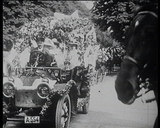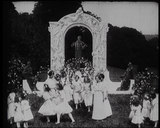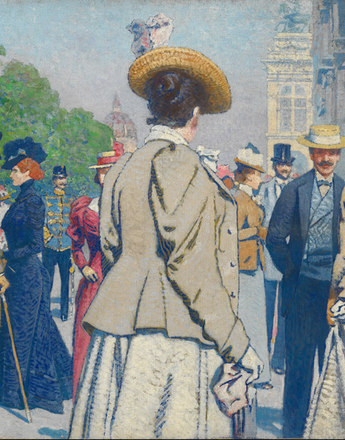Capturing the unusual: the Vienna Prater
Old photographs and early film recordings show that photographers and film-makers – whether professional or amateur – liked to record unusual events, such as a visit to the Prater, as a means of preserving the special and memorable moments, a day of carefree happiness that can be relived for an instant.
The Prater is a place that has always specialized in offering fun and escape from humdrum reality. It is not surprising that in the early days of cinema the Vienna amusement park exerted a captivating fascination for the people behind the camera. There was so much to see: new technical apparatus, exotic attractions, strange worlds and, above all, the visitors, who sought a moment of freedom and happiness among the thrills and spills.
The first film projections in the Prater date back to 1896, and from 1905 the amusement park was also a cinematographic centre within the city. Baroque-like façades, such as that of the Krystall Kino with its distinctive onion towers, became iconic cinematographic objects. It was the right place for the new medium, with its voyeuristic culture that was not only openly celebrated but was also part of the spectacle. There were unusual people of all shapes and sizes: artistes, midgets and giants, strongmen, snake charmers and trick-shot artists. The public loved these freaks of nature, who turned their differentness into something special. One person who was able to transform his physical peculiarity into a ‘first-class attraction’ was the ‘Rump Man’ and Prater entrepreneur Karl Kobelkoff. He had learnt to paint, shoot and lift weights with the stumps of his arms and raised these skills to the level of art. Kobelkoff was an opportunist with a difference, who founded a Prater dynasty that still exists today (Kobelkoff, F 1899).
Since the nineteenth century the Prater was a place to see and be seen. Viennese society strolled and promenaded, observed and was observed. It was an ideal place to show off. One form of discreet ‘bourgeois’ voyeurism was the traditional May Flower Parade (F c. 1908). In 1896 Princess Pauline Metternich introduced a spring festival in the Prater for Viennese society. Every year the Viennese admired the magnificently decorated carriages and automobiles in the parade. There were also concerts, sporting and artistic events on the side.
The Prater became the most important amusement park in the imperial capital and residence. It was highly popular as the site of the World’s Fair in 1873. Coffee houses had been established along the Hauptallee since the eighteenth century, where dance orchestras, including one conducted by Johann Strauss, would play. The Waltz King was an idol admired long after his death. A biography, with a few added fictional details, entitled Johann Strauss an der schönen blauen Donau [Johann Strauss on the Beautiful Blue Danube] (A 1913), was made about the great artist fourteen years after he died. The film turned the Master of Operetta into a national monument. At the end of the film, a May Day celebration takes place in the Stadtpark. Hansi Niese, a popular actress and star of the time, pays tribute to the immortal composer in front of the real monument to him.
The new cultural streams of Vienna 1900 and the Modernist era, such as the Secession and its representatives or the composers Gustav Mahler and Arnold Schönberg, did not feature in these contemporary cinematographic tributes or documentation, as they had not yet become official cultural canons.
Translation: Nick Somers
Ballhausen, Thomas/Krenn, Günter: „Dem Schönen ein Heim“. Physische Abnormitäten und als Attraktionen zwischen Präsentation und Repräsentation, in: Dewald, Christian/Schwarz, Werner Michael: Prater Kino Welt. Der Wiener Prater und die Geschichte des Kinos, Wien 2005, 265-278
Grafl, Franz: Praterbude und Filmpalast. Wiener Kino-Lesebuch, Wien 1993
-
Chapters
- Cinematic fascination: the machine in war propaganda
- Mobility in film: conquering new spaces
- The thrill of speed in film: heroes of the road and air
- Voyaging and travelling: tourism and tourism films
- Capturing the unusual: the Vienna Prater
- Movement in films – sport, gymnastics and physical culture
- Power and the public: political movements in historical films





